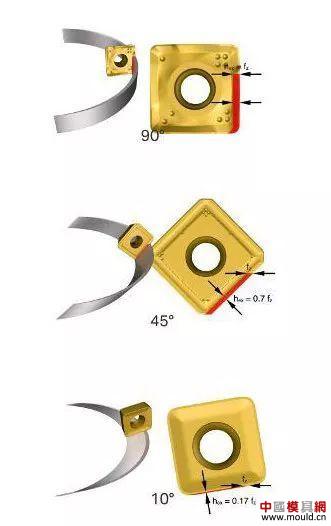To ensure the efficiency of the milling process, there are many factors to consider, such as using the right milling tool, using the correct diameter and the appropriate number of teeth, and using the correct speed, feed rate, axial depth of cut, and radial width. However, in order to ensure the effectiveness of tool applications, there are many more important but often overlooked factors.
Comprehensive consideration of the five major milling factors that determine production efficiency and profitability: the main declination angle, tooth pitch, milling cutter position, milling knife allowance and arc cutting-in technique.
Main angle

The influence of different declination angles on the milling effect is very significant. If a 90° milling cutter is used as a face milling cutter, it is often because of its ease of use, but its productivity or cost efficiency is not as good as a 45° milling cutter. The use of 90° cutter face milling parts, instead of 45° milling cutters, reduces production efficiency by 30%, and production efficiency directly affects profitability.
Mainly, the lead angle affects the metal removal rate and tool life. In addition, because the primary angle decreases, the chip thickness becomes thinner, and as such, there is an opportunity to increase the feedrate to compensate. Nowadays, more and more processing workshops use small depth of cut and high feed rates to increase production efficiency, usually using milling cutters with a small primary angle (for example, 10°), or using circular blades that can achieve chip thinning effects concept. Compared with the 45° face milling cutter, the 10° face milling cutter increases the feed because the chips are thinned to almost one sixth of the 90° milling cutter. If this strategy results in deep cuts, a high feedrate can be used to compensate for the loss of efficiency.
For large feed milling cutters with a leading angle of 10°, a very high table feed rate can be used because the resulting chips are very thin. In addition, the axial cutting force is large, which can ensure the stability of the spindle and limit the vibration, making these cutters more suitable for long tool overhangs and/or unstable clamping applications.
For 45° cutters, these are often the first choices for face milling because they balance the radial cutting force and axial cutting force very well and the knife is very smooth. These milling cutters have low vibration and are suitable for short-stem material (such as gray cast iron). Such materials have fewer and fewer workpieces at the end of the pass. If the radial forces are too large, they will easily collapse.
If a 90° milling cutter is used as a face milling cutter, it is often because of its ease of use, but its productivity or cost efficiency is not as good as a 45° cutter. For large feed milling cutters with a leading angle of 10°, a very high table feed rate can also be used due to the thin chips formed.
The main application of the 90° cutter is square shoulder milling. In this application, radial forces are mainly generated in the feed direction and are most suitable for milling parts that are prone to vibration. In addition, the surface is not subjected to large axial pressures, which is beneficial for structural parts or thin-walled parts that do not have great milling strength. It must be noted that the 90° cutter cannot form thin chips, and the programmed feed per tooth is equal to the actual maximum chip thickness at large cut widths.
So, what about round inserts? Circular inserts are best suited for efficient heavy duty roughing and universal milling.
Round inserts are particularly suitable for processing titanium alloys and HRSA materials, but the effect is not optimal when pursuing high surface finishes. This is because the leading angle changes from 0 to 90°, which causes the cutting force to change with the arc cutting edge, and the pressure also changes. The unique properties of the round blade result in a change in the chip thickness that varies with depth of cut - the smaller the depth of cut, the thinner the chips. Therefore, if the cut depth is small, the feed rate must be increased to ensure proper chip thickness and improve production efficiency.
By increasing the number of cutting edges, the pitch can increase the amount of table feed, while maintaining the cutting speed and the amount of feed per tooth (the cutting edge will not emit a large amount of heat). However, the denser the tooth pitch, the smaller the swarf space. In addition, increasing the number of inserts in the milling cutter has the disadvantage that if the clamping is not sufficiently rigid, it has a negative effect on the vibration. The use of unequal-pitch cutters optimizes the application. It is also important to choose the correct pitch because it can affect production efficiency, stability and power consumption.
In general, there are three tooth pitches: sparse, dense, and ultra-dense. The sparse milling cutter has fewer blades. Due to their low cutting forces, they are the first choice for unstable processes. Full groove milling process and long chip ISO N material are best suited for use with sparse milling cutters.
The cutters have a medium number of inserts, either equally spaced or not. They are the first choice for general roughing in stable conditions. The benefits also include the ability to efficiently process all materials without worrying about chip space issues.
In general, uneven milling cutters (lips or denticles) are best suited to break the resonance and therefore have good stability.
Ultra-dense tooth cutters have many blades and the blades are evenly distributed. Ultra-tooth cutters are best suited for applications with small radial widths, high feed rates (roughing and finishing) with shorter chips in ISO K materials, rough machining of ISO S materials due to the use of round inserts, even chip distribution .
Milling cutter position
The way the cutter cuts into the workpiece is important. At this point, the first thing to consider is how the chips are formed because this seriously affects tool life. The golden rule is that the chips are thicker and thinner (when the cutter cuts the workpiece, the chip thickness is the thinnest). This saves time and money and ensures the stability of the process. In comparison, thick cuttings when the cutter cuts the workpiece can lead to blade failure and shortened tool life. The important thing is that it is the position of the milling cutter that determines the chip condition.
For example, in full-slot milling, after the cutter is fully cut into the workpiece, the resulting chip thickness is thin to thin. Although the cuttings are very thin when the cutter cuts the workpiece, this method has many problems because the heat cannot be discharged but can only enter the tool or the workpiece—not the chip, because there is no chip at all. When the edge of the milling cutter cuts into the workpiece, the cutting edge only rubs the material, not the shear material, which generates heat and vibration.
However, by optimizing the position of the milling cutter, for example, the width of the cutter can reach 70% of the diameter of the cutter. The effect is that the maximum chip thickness of 90%, the small stress on the blade, and the friction reduction can be achieved by cutting. It can be used for milling, reverse milling, cutting and thinning chips, good heat dissipation, and low blade stress.

By optimizing the position of the milling cutter, this situation can be greatly improved, in which the amount of knife can reach 70% of the cutter diameter.
Pay attention to the correct direction of the cutting tool into the workpiece. If it is not correct, even if the width of the milling cutter reaches 70% of the diameter, a thin, thicker chip can be formed, shortening the tool life when cutting into the workpiece, and increasing the cost.
Milling cutters and arc cutting skills
When milling parts, it is recommended that the milling cutter stays knifed. Milling cutters frequently cut in and out, shortening tool life. In order to solve this problem, the most important thing is the correct path and contact length. Continuous knife also need to be reminded that sudden changes in the direction of the knife when continuously eating the knife will stress the blade, and the formation of thick cutting chips, it is recommended that the arc at the corner of the workpiece cutting path.
Straight feeds can result in poor surface finish and high noise.
In order to alleviate this contradiction, in most cases it is to reduce the feed, but at the same time it also reduces the production efficiency. A simple solution to this situation is to change programming to clockwise arc cutting. Using this smooth and continuous cutting method can extend tool life and optimize wear patterns. When the cutter is cut out, the chips are thin and the vibration is small.

Continuous knife, clockwise circular cut into, to ensure that the chip when the knife is thin, reduce vibration, extend tool life.
When cutting into the workpiece, it is recommended to use the arc cutting technique, and when the cutter continuously eats a knife, if you need to abruptly change the feed direction of the milling cutter suddenly, it is better to use arc transition. These techniques prevent the blade from being subjected to significant stress, which not only extends the tool life, but also improves the surface finish of the part by reducing the thickness of the chip.
Use arc cutting techniques, correct cutter position and continuous knife to ensure safe and efficient machining.
Idler Steel Conveyor Roller,Roller Parts,Heavy Duty Gravity Roller,Steel Conveyor Roller
Wuxi Sixleaf Machinery Co. LTD , https://www.sixleafmachine.com